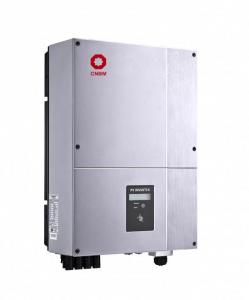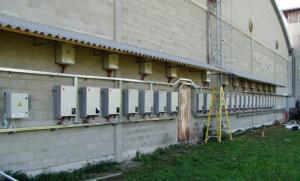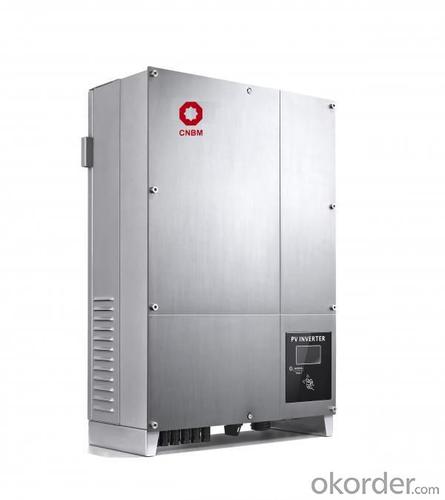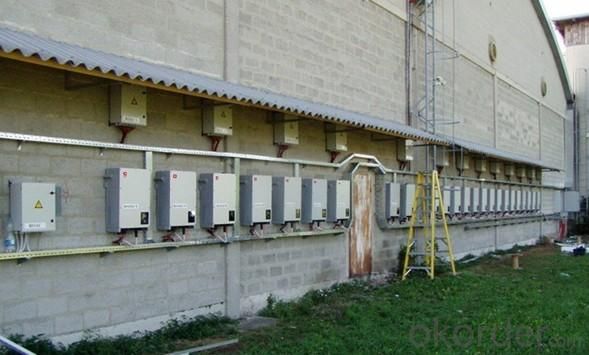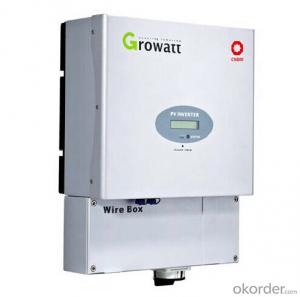Homage Solar Inverter Grid Tied 3-Phase CNBM-10000UE
- Loading Port:
- NanJing
- Payment Terms:
- TT
- Min Order Qty:
- 1 set set
- Supply Capability:
- 1000/month set/month
OKorder Service Pledge
OKorder Financial Service
You Might Also Like
Features of Grid Tied Solar Inverter 3-Phase CNBM-10000UE
CNBM International Corporation (CNBM International) is the most important trading platform of CNBM Group Corporation, a state-owned company under the direct supervision of State-owned Assets Supervision and Administration Commission of the State Council.
With a R&D team more than 100 engineers,40% of the staff, who has been deeply engaged in the photovoltaic industry for 10 years, CNBM takes the mission to increase the inverter availability and efficiency, putting continuous innovation to make CNBM inverter easier for installation and operation, and more cost-effective for solar plant construction. The full range of CNBM single phase inverters has received VDE, CE, G83/1, G59/2, ENEL2010, VDE4105, C10/C11, AS4777 etc.
Maximum efficiency of 97.8% and wide input voltage range, Internal DCswitch,MTL-String, Sound control,Bluetooth/RF technology /WiFiTransformerless,GT topology
The Grid Connected Solar Inverter we can offer is 1.5kw to 20kw.
Introduction of Grid Tied Solar Inverter 3-Phase CNBM-10000UE
Maximum efficiency of 97.8% and wide input voltage range
Integrated DC switch-disconnected
MTL-String
Sound control
Bluetooth/RF technology /Wi-Fi
Transformerless GT topology
5 years warranty (10 years as optional)
Technical data of Grid Tied Solar Inverter 3-Phase CNBM-10000UE
Model | CNBM-10000UE | CNBM-12000UE | |
Input data (DC) |
|
| |
Max. DC power | 10500W | 12500W | |
Max. DC voltage | 1000V | 1000V | |
Start voltage | 350V | 350V | |
PV voltage range | 180V-1000V | 180V-1000V | |
Max. input current | 15A | 17A | |
Number of MPP trackers /strings per MPP tracker | 2/2 | 2/2 | |
Output (AC) |
| ||
Rated AC output power | 10000W | 12000W | |
Max. AC power | 10000VA | 12000VA | |
Max. output current | 16A | 19A | |
Power factor | 1 | 1 | |
THDI | <3% | <3% | |
AC connection | Three phase | Three phase | |
Efficiency |
| ||
Max. efficiency | 98% | 98% | |
Euro weighted efficiency | 97.5% | 97.5% | |
MPPT efficiency | 99.5% | 99.5% | |
Protection devices |
| ||
Output over voltage protection-varistor | yes | yes | |
Ground fault monitoring | yes | yes | |
Grid monitoring | yes | yes | |
General Data |
| ||
Dimensions (W / H / D) in mm | 740/440/235 | 740/440/235 | |
Weight | 41KG | 41KG | |
Operating temperature range | –25°C ... +60°C | –25°C ... +60°C | |
Altitude | 2000m(6560ft) without derating | ||
Self-Consumption night | < 0.5 W | < 0.5 W | |
Topology | Transformerless | ||
Cooling concept | Natural | Natural | |
Environmental Protection Rating | IP65 | IP65 | |
Features |
| ||
DC connection | H4/MC4(opt) | H4/MC4(opt) | |
Display | LCD | LCD | |
Interfaces: RS485/RS232/Bluetooth / RF/Zigbee/Wifi | yes/yes/opt/opt/opt | ||
Warranty: 5 years / 10 years | yes /opt | ||
Certificates and approvals | CE、VDE 0126-1-1、DK5940、G83/1-1、G59/2、RD1663、EN50438、 VDE-AR-N4105、CEI-021、IEC-62109、ENEL-Guide | ||
Grid Tied Solar Inverter 3-Phase CNBM-10000UE is simple national setting of line supply monitoring, Easy country configuration, with Multi-language,display, currently available for most of the countries over the world.With technical creativity and scientific management, the factory established first class R&D and test centers, as well as management and R&D teams comprising of PhDs and masters with overseas qualification.
Figure 1 the application of Grid Tied Solar Inverter 3-Phase CNBM-10000UE
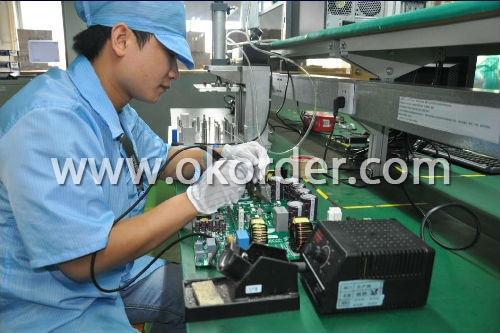
Figure 2 The Stock of Grid Tied Solar Inverter 3-Phase CNBM-10000UE

- Q: What is the difference between a string inverter and a micro inverter?
- A string inverter is a type of inverter that is connected to a string of solar panels, converting the DC power generated by the panels into AC power for use in the electrical grid. On the other hand, a micro inverter is a smaller and individual inverter that is attached to each solar panel, converting the DC power directly at the panel level. The main difference between the two is that a string inverter operates at the string level, which means if one panel in the string is affected by shade or malfunction, the entire string's performance is affected. In contrast, with micro inverters, each panel operates independently, allowing for higher energy production and better performance in situations where panels are subjected to shading or varying conditions.
- Q: Can a solar inverter be used with a solar-powered educational system?
- Yes, a solar inverter can be used with a solar-powered educational system. A solar inverter is responsible for converting the direct current (DC) produced by solar panels into alternating current (AC) that can be used to power electrical devices. In the case of a solar-powered educational system, the solar inverter plays a crucial role in converting the DC energy generated by the solar panels to AC energy that can be utilized by the educational equipment, such as computers, projectors, or other electrical devices, thereby enabling the system to function efficiently.
- Q: How does a solar inverter impact the payback period of a solar system?
- A solar inverter plays a crucial role in the payback period of a solar system. It converts the direct current (DC) electricity generated by solar panels into alternating current (AC) electricity that is usable for homes or businesses. A high-quality solar inverter ensures maximum energy efficiency, allowing the solar system to generate and utilize more electricity effectively. By optimizing energy production, a solar inverter can significantly reduce the payback period of a solar system, allowing users to recoup their initial investment and start saving on electricity bills more quickly.
- Q: What is the role of a power factor correction circuit in a solar inverter?
- The role of a power factor correction circuit in a solar inverter is to improve the power quality and efficiency of the inverter by reducing the reactive power and improving the power factor. This circuit ensures that the energy from the solar panels is effectively converted and delivered to the electrical grid, leading to a more stable and efficient operation of the solar inverter system.
- Q: How does a solar inverter handle power factor correction?
- A solar inverter handles power factor correction by using advanced control algorithms and circuitry to actively manage and adjust the power factor of the electrical output. It does this by continuously monitoring the load and adjusting the phase angle and voltage to ensure that the power factor remains close to unity (1.0). This helps optimize the efficiency of the solar system and ensures that the power being generated is in sync with the grid requirements.
- Q: What is the maximum operating temperature of a solar inverter?
- The maximum operating temperature of a solar inverter can vary depending on the specific model and brand. However, most solar inverters are designed to operate within a temperature range of -20°C to 60°C (-4°F to 140°F). It is important to check the manufacturer's specifications to determine the exact maximum operating temperature for a particular solar inverter.
- Q: What is the difference between a grid-tied and off-grid solar inverter?
- A grid-tied solar inverter is designed to work with the traditional utility grid. It converts the DC power generated by solar panels into AC power that can be used in the home or business, and any excess power can be fed back into the grid. In contrast, an off-grid solar inverter is used in standalone systems, where there is no connection to the utility grid. It converts the DC power generated by solar panels into AC power for immediate use or for storage in batteries, ensuring a reliable power supply in isolated areas or during power outages.
- Q: Can a solar inverter be used in regions with high humidity or moisture levels?
- Yes, solar inverters can be used in regions with high humidity or moisture levels. However, it is important to ensure that the inverters are designed and built to withstand such conditions. Waterproof or moisture-resistant features may be necessary to protect the inverters from potential damage caused by moisture or humidity. Regular maintenance and monitoring are also recommended to ensure optimal performance in such environments.
- Q: Can a solar inverter be used with a three-phase electrical system?
- Yes, a solar inverter can be used with a three-phase electrical system. In fact, many commercial and industrial solar installations use three-phase inverters to convert the direct current (DC) power generated by solar panels into alternating current (AC) power that can be used by the electrical grid. This allows for efficient power conversion and distribution in three-phase systems, which are commonly used in larger electrical installations.
- Q: Can a solar inverter be used with solar-powered irrigation systems?
- Yes, a solar inverter can be used with solar-powered irrigation systems. The solar inverter converts the direct current (DC) produced by the solar panels into alternating current (AC) that can be used to power the irrigation system. This allows for the efficient and effective utilization of solar energy in irrigating crops or plants.
Send your message to us
Homage Solar Inverter Grid Tied 3-Phase CNBM-10000UE
- Loading Port:
- NanJing
- Payment Terms:
- TT
- Min Order Qty:
- 1 set set
- Supply Capability:
- 1000/month set/month
OKorder Service Pledge
OKorder Financial Service
Similar products
Hot products
Hot Searches
Related keywords

